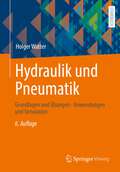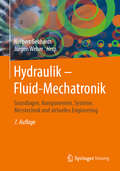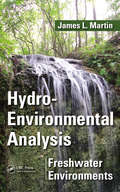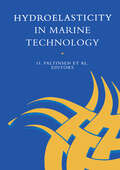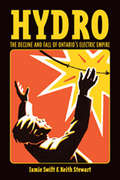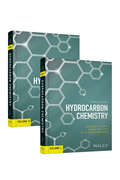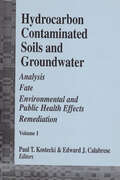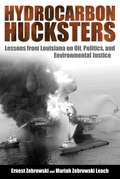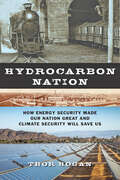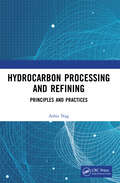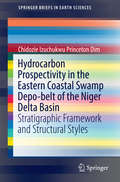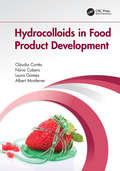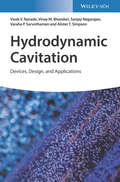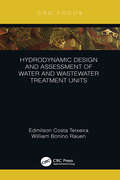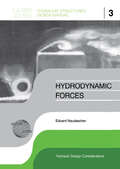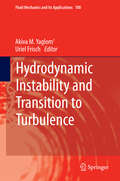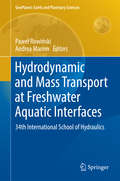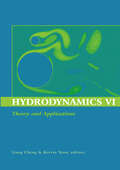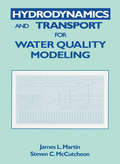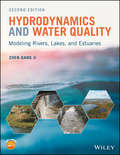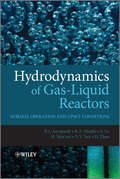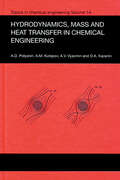- Table View
- List View
Hydraulik und Pneumatik: Grundlagen und Übungen - Anwendungen und Simulation
by Holger WatterDieses Lehr- und Übungsbuch vermittelt das Grundlagenwissen zu hydraulischen und pneumatischen Systemen. Mit starkem Praxisbezug werden wichtige Konstruktionselemente und deren Regelung behandelt, nachdem die Grundsteine in der Fluidmechanik und der Stofflehre der Hydraulikflüssigkeiten gelegt wurden. Eine Vielzahl an Berechnungs- und Übungsbeispielen mit Lösungen und ergänzenden Hinweisen hilft dabei, das Verständnis der Wirkzusammenhänge zu vertiefen. Die Simulationstechnik und zugehörige Beispiele runden das Buch ab und vermitteln wichtige Kompetenzen in der Beurteilung entsprechender Ergebnisse. In der aktuellen Auflage wurden einige Abbildungen erneuert und unter anderem eine Aufgabe zur Simulation einer Mobilhydraulik ergänzt.
Hydraulik – Fluid-Mechatronik: Grundlagen, Komponenten, Systeme, Messtechnik und virtuelles Engineering
by Jürgen Weber Norbert GebhardtDas bewährte Fachbuch wurde in der 7. Auflage stark überarbeitet und umfangreich ergänzt, so dass der Einstieg in das Gebiet Hydraulik für den Leser noch besser und schneller möglich ist. Mehr und mehr kann es als Nachschlagewerk für offene Fachprobleme genutzt werden. Die Kapitel behandeln die physikalischen und technischen Grundlagen der Hydraulik, gehen auf die Eigenschaften der Druckflüssigkeit als Energieübertragungsmedium ein und stellen neben den hydraulischen Komponenten auch die für die Inbetriebnahme und den Betrieb von hydraulischen Anlagen erforderlichen Sensoren und Messgeräte vor. Neben einer umfangreichen Darstellung typischer Systemarchitekturen findet der Leser ebenso ausführliche Erläuterungen zur Regelung hydraulischer Antriebe. Grundlagen zur Modellierung und Simulation komplexer Hydrauliksysteme sind weitere Inhalte des Buches. Generell wird ein stärkerer Praxisbezug hergestellt.Die ZielgruppenKonstrukteure, Anwender und Betreiber hydraulischer AnlagenIngenieure und Studenten des Maschinenbaus Nachschlagwerk für in der Praxis tätige Hydrauliker
Hydro-Environmental Analysis: Freshwater Environments
by James L. MartinFocusing on fundamental principles, Hydro-Environmental Analysis: Freshwater Environments presents in-depth information about freshwater environments and how they are influenced by regulation. It provides a holistic approach, exploring the factors that impact water quality and quantity, and the regulations, policy and management methods that are ne
Hydro-elasticity in Marine Technology: Proceedings of an international conference, Trondheim, Norway, 22-28 May 1994
by O. FaltinsenIn considering hydro-elasticity in marine technology, this text covers proceedings papers on risers of floating production platforms, cables, pipelines, flexible containers, seal bag system of surface effect ships, slamming on ships, whipping, and springing of ships, TLPs and very large floating structures.
Hydro: The Decline and Fall of Ontario's Electric Empire
by Jamie Swift Keith Stewart“Nothing is going to go wrong.” -Mike Harris, 2001 Privatization of power soon became one of the biggest political disasters in Ontario history. Hydro reveals a train wreck that was decades in the making. First there was blind faith in the nuclear option, steeped in ecological arrogance. Then came the promise of marketplace magic. Jamie Swift and Keith Stewart tell the tale of how it unfolded. It’s a dramatic story of the greed, intrigue, and resistance that led to the dismantling of Canada’s largest crown corporation. A crucial part of the story is how Ontario ignored thirty years of green arguments for conservation and renewable energy. Based on interviews with former premiers, Hydro insiders, and grassroots activists, Hydro will intrigue anyone wondering how to keep the lights on without frying the planet.
Hydrocarbon Chemistry
by George A. Olah G. K. Prakash Arpad MolnarThis book provides an unparalleled contemporary assessment of hydrocarbon chemistry – presenting basic concepts, current research, and future applications.• Comprehensive and updated review and discussion of the field of hydrocarbon chemistry• Includes literature coverage since the publication of the previous edition• Expands or adds coverage of: carboxylation, sustainable hydrocarbons, extraterrestrial hydrocarbons• Addresses a topic of special relevance in contemporary science, since hydrocarbons play a role as a possible replacement for coal, petroleum oil, and natural gas as well as their environmentally safe use• Reviews of prior edition: “...literature coverage is comprehensive and ideal for quickly reviewing specific topics...of most value to industrial chemists...” (Angewandte Chemie) and “...useful for chemical engineers as well as engineers in the chemical and petrochemical industries.” (Petroleum Science and Technology)
Hydrocarbon Contaminated Soils and Groundwater: Analysis, Fate, Environmental & Public Health Effects, & Remediation, Volume I
by Edward J. Calabrese Paul T. Kostecki Charles E. BellProceedings of the February 19-22, 1990, conference held at Newport Beach, California. ConferenceDirectors: PAUL T. KOSTECKI, EDWARD J. CALABRESE, and CHARLES E. BELL. Advisory Committee: RICHARD BOZEK, EEI; TERRY BRAZEL, SWRCB; MARK COUSINEAU, AG; SETH DAUGHERTY, Orange County; RALPH De La PARRA, SCE; JERRY HAGGY, Shell; JOHN HANBY, HAL; JOHN HILL, ICF; JOHN HILLS, City of Anaheim; DOROTHY KEECH, Chevron; BILL KUCHARSKI, WC; DAVID LEU, Mittel Hauser; MARY McLEARN, EPRI; PHIL OLWIN, Texaco; DENNIS PAUSTENBACH, MC; ART POPE, ARCO; LYNNE PRESLO, Weston; DON ROTHENBAUM, KA; KIM SAVAGE, EPA/OUST; CARL SHUBERT, IT; WENDELL SUYAMA, Lockheed; MICHAEL WANG, WSPA; JOHN WILLIAMS, TT; and WILLIAM WINTERS, AEM.
Hydrocarbon Hucksters: Lessons From Louisiana on Oil, Politics, and Environmental Justice
by Ernest Zebrowski Mariah Zebrowski LeachHydrocarbon Hucksters is the saga of the oil industry's takeover of Louisiana--its leaders, its laws, its environment, and, by rechanneling the flow of public information, its voters. It is a chronicle of mindboggling scientific and technical triumphs sharing the same public stew with myths about the "goodness" of oil and bald-faced public lies by politicians and the captains of industry. It is a story of money and power, greed and corruption, jingoism and exploitation, pollution and disease, and the bewilderment and resignation of too many of the powerless. Most importantly, Hydrocarbon Hucksters is a case study of what happens when a state uncritically hands the oil and petrochemical industries everything they desire. Today, Louisiana ranks at or near the bottom of the fifty states on virtually every measure related to the quality of life--income, health, education, environment, public services, public safety, physical infrastructure, and vulnerability to disasters (both natural and man-made). Nor, contrary to the claims of the hydrocarbon sector, has there been much in the way of job creation to offset all of this social grief. The authors (one a scientist, the other an environmental lawyer) have woven together the science, legal history, economic issues, and national and global contexts of what has happened. Their objective is to raise enough national awareness to prevent other parts of the United States from repeating Louisiana's historical follies. The authors are uncle and niece, a generation apart, who have melded their conclusions from two separate tracks.
Hydrocarbon Nation: How Energy Security Made Our Nation Great and Climate Security Will Save Us (The Johns Hopkins University Studies in Historical and Political Science #133)
by Thor HoganUnderstanding the complex history of US fossil fuel use can help us build a sustainable future.In Hydrocarbon Nation, Thor Hogan looks at how four technological revolutions—industrial, agricultural, transportation, and electrification—drew upon the enormous hydrocarbon wealth of the United States, transforming the young country into a nation with unparalleled economic and military potential. Each of these advances engendered new government policies aimed at strengthening national and economic security. The result was unprecedented energy security and the creation of a nation nearly impervious to outside threats. However, when this position weakened in the decades after the peaking of domestic conventional oil supplies in 1970, the American political and economic systems were severely debilitated. At the same time, climate change was becoming a major concern. Fossil fuels created the modern world, yet burning them created a climate crisis. Hogan argues that everyday Americans and policymakers alike must embrace the complexity of this contradiction in order to help society chart a path forward. Doing so, Hogan explains, will allow us to launch a critically important sustainability revolution capable of providing energy and climate security in the future. Hydrocarbon Nation provides reasons to believe that we can succeed in expanding on the benefits of the Hydrocarbon Age in order to build a sustainable future.
Hydrocarbon Processing and Refining: Principles and Practices
by Ashis NagThis book covers petroleum refining and gas purification processes, including refinery configurations comprising of relevant units with special emphasis on processing of heavy crudes with high acid number. It includes a short review of distillation principles, distillation column auxiliaries, critical column pressure control strategies, critical issues of crude and vacuum distillation units particularly for heavy crude processing. Different corrosion mechanisms and their prevention with regards to heavy high TAN crude processing are also included. Fundamentals are explained with support of steady-state simulation and presented with simulation flowsheets and outputs, supported by examples of calculations and troubleshooting case studies. Features: • Deals with principles and practices in the hydrocarbon industry and petroleum refinery with emphasis on heavy crude processing • Focuses on operation and practices of the major process units with simulation examples and aimed at the professional engineer • Covers acid gas treatment in view of increased emphasis on carbon capture and storage, and introduction of residue gasification processes • Elucidates methodologies for safety relief load computation for distillation columns • Explains real-life problems in reboilers, column internals, column pressure controls and corrosion in crude, and vacuum distillation and secondary units with several case studies This book is aimed at professionals in petroleum engineering and graduate students in chemical engineering.
Hydrocarbon Prospectivity in the Eastern Coastal Swamp Depo-belt of the Niger Delta Basin
by Chidozie Izuchukwu Princeton DimThis book broadens readers' understanding of the stratigraphic framework and structural styles for improved hydrocarbon prospectivity in the intermediate and deeper horizons of the eastern Coastal Swamp Depo-belt of Nigeria's Niger Delta Basin. It equips readers to interpret complex sedimentary units, such as the paralic sequence of the Niger Delta Basin, using sequence stratigraphic tools integrated with well logs, biostratigraphic, paleobathymetric and seismic data. It also offers numerous tips and insights into reservoirs, seals, source rocks and hydrocarbon-type trends/distribution across several production fields, and provides a valuable guide to support exploration and production.
Hydrocarbon and Lipid Microbiology Protocols: Single-Cell and Single-Molecule Methods (Springer Protocols Handbooks #0)
by Kenneth N. Timmis Balbina Nogales Terry J. McGenityThis Volume presents relevant single-cell and single-molecule approaches in the study of microbes producing and utilizing hydrocarbons and lipids. While generically applicable for all microorganisms, the approaches described are, wherever possible, adapted to the field of study of hydrocarbon and lipid microbiology. The methods include basic procedures for isolating single cells by means of microfluidics and flow cytometry, and their cultivation in arrays as pure clones; for isolating, amplifying and sequencing single-cell genomes and transcriptomes; and for analysing single-cell metabolomes by means of Raman spectroscopy. Single-molecule approaches include the use of protein:fluorescent dye fusions for protein localization and methods for the production of cell division protostructures and lipid monolayers. Methods for the functional analysis of single cells include detection of metabolically active (protein-synthesizing) cells in environmental samples by bioorthogonal non-canonical amino acid tagging, Raman spectroscopy combined with stable isotope labelling and fluorescent in situ hybridisation, and visualization of single cells participating in gene transfer activity. Lastly, protocols are presented for single-cell biotechnological applications, including biofuel production.Hydrocarbon and Lipid Microbiology ProtocolsThere are tens of thousands of structurally different hydrocarbons, hydrocarbon derivatives and lipids, and a wide array of these molecules are required for cells to function. The global hydrocarbon cycle, which is largely driven by microorganisms, has a major impact on our environment and climate. Microbes are responsible for cleaning up the environmental pollution caused by the exploitation of hydrocarbon reservoirs and will also be pivotal in reducing our reliance on fossil fuels by providing biofuels, plastics and industrial chemicals. Gaining an understanding of the relevant functions of the wide range of microbes that produce, consume and modify hydrocarbons and related compounds will be key to responding to these challenges. This comprehensive collection of current and emerging protocols will facilitate acquisition of this understanding and exploitation of useful activities of such microbes.
Hydrocolloids in Food Processing (Institute of Food Technologists Series #47)
by Thomas R. LaamanIn Hydrocolloids in Food Processing, a group of the most experienced and impartial experts explains what stabilizers should be used and how they should be used, food product by food product. Numerous actual product formulations are packed into each chapter and the processing procedures to make these formulations are clearly described. Food manufacturers are shown how to accurately use food stabilizers to make the highest quality food products. Coverage includes all the practical details needed to ensure the most accurate QA standards and testing procedures for each hydrocolloid. Finally, Hydrocolloids in Food Processing explains how to navigate the often tricky area of dealing with hydrocolloid suppliers. An informative discussion of how hydrocolloid companies think and operate today is followed by precise strategies to ensure that the most mutually beneficial relationships can be obtained between specific customer types and appropriate types of suppliers.
Hydrocolloids in Food Product Development
by Laura Gómez Clàudia Cortés Núria Cubero Albert MonferrerThis book is an essential manual for professionals and students who wish to deepen their knowledge of food additives that modify the texture of food, thickeners and gelling agents. When it comes to food technology, hydrocolloids are generally introduced as additives. Other ingredients, not considered additives, are also hydrocolloids, for example proteins and starches. This manual only focuses on those considered additives, except modified starches. Newly translated from Spanish to English, Hydrocolloids in Food Product Development is written by four experts in their field who are familiar with offering technical advice to companies related to the manufacturing of food. After an introductory chapter that reviews chemical characteristics, the hydration and solubilization of hydrocolloids, the preparation of hydrocolloids solutions, and technological functions, subsequent chapters present different hydrocolloids used in food technology and describe its technical features and its most common uses. Key Features: Describes technical and utilization characteristics of thickeners and gelling agents Details the origin, physical-chemical characteristics, form of use, function, synergies, incompatibilities and examples of use Graphs, tables, photographs and diagrams provided in full color for easy reading comprehension This practical manual is designed so that food industry technicians and chefs may easily consult while doing their daily work, or so that students of degrees related to food technology may use it as a reference book.
Hydrodynamic Cavitation: Devices, Design and Applications
by Vivek V. Ranade Vinay M. Bhandari Sanjay Nagarajan Varaha P. Sarvothaman Alister T. SimpsonHydrodynamic Cavitation A systematic introduction to critical technologies and applications of hydrodynamic cavitation In Hydrodynamic Cavitation: Devices, Design, and Applications, a distinguished team of researchers delivers an authoritative discussion of key aspects of hydrodynamic cavitation, including the design, characterization, and modeling of the devices. The book offers discussions of state-of-the-art applications of the technology, including the disinfection of water, wastewater treatment, biomass processing, and many other industrial applications. In addition to expansive case studies, the book provides an up-to-date exploration of emerging innovations and future applications of the technology. Readers will also find: A thorough introduction to hydrodynamic cavitation devices, including those based on axial and rotational flows An in-depth examination of the experimental characterization of cavitation devices and computational models Comprehensive explorations of the applications of hydrodynamic cavitation, including the disinfection of water and wastewater treatment Accessible discussions of industrial applications of hydrodynamic cavitation Perfect for chemical and process engineers, water chemists, mechanical engineers, and food chemists, Hydrodynamic Cavitation will also earn a place in the libraries of food and environmental technologists.
Hydrodynamic Control of Wave Energy Devices
by Umesh A. Korde John V. RingwoodWith this self-contained and comprehensive text, students and researchers will gain a detailed understanding of the fundamental aspects of the hydrodynamic control of wave energy converters. Such control is necessary to maximise energy capture for a given device configuration and plays a major role in efforts to make wave energy economic. Covering a wide range of disciplines, the reader is taken from the mathematical and technical fundamentals, through the main pillars of wave energy hydrodynamic control, right through to state-of-the-art algorithms for hydrodynamic control. The various operating principles of wave energy converters are exposed and the unique aspects of the hydrodynamic control problem highlighted, with a variety of potential solutions discussed. Supporting material on wave forecasting and the interaction of the hydrodynamic control problem with other aspects of wave energy device optimisation, such as device geometry optimisation and optimal device array layout, is also provided.
Hydrodynamic Design and Assessment of Water and Wastewater Treatment Units
by Edmilson Costa Teixeira William Bonino RauenWater and wastewater treatment normally take place in a series of continuous flow units, each designed to perform a step of the intended purification process - typically involving coagulation or flocculation, sedimentation or filtration, and disinfection. The flow pattern governs the residence/contact time, turbulence levels, collisions and shear to which different fluid portions are subjected in their passage through the unit. The efficiency of a given unit depends as much on the relevant physical, chemical or biological reaction as on the flow pattern taking place inside. This combined effect of flow features on process efficiency is often overlooked in teaching the design of water and wastewater treatment units, and so it is not uncommon to find treatment units in operating in a cost-ineffective way, causing health and environmental problems. This book introduces engineering students to concepts and practical measures associated with the rational design of treatment units, leading to more realistic and potentially optimal solutions for new units as well as for retrofitting existing units. Key basic concepts and suitable analytical tools are described, illustrated and worked through using practical examples. Engineering undergraduates and graduates should benefit from the book while undertaking standalone modules on the topic and/or supplementary classes of existing courses on unit treatment processes. The book may also be useful for technical and engineering staff involved in designing and/or retrofitting units for better cost-effectiveness and footprint reduction of the water and wastewater treatment sector.
Hydrodynamic Forces: IAHR Hydraulic Structures Design Manuals 3 (IAHR Design Manual #No. 3)
by Eduard NaudascherProduced for the International Association for Hydraulic Research, this monograph covers fluctuating and mean hydrodynamic forces, hydrodynamic forces on high-head gates, and hydrodynamic forces on low-head gates i.e. only the forces induced by flow incident or past the structure.
Hydrodynamic Instability and Transition to Turbulence
by Uriel Frisch Akiva M. YaglomThis book is a complete revision of the part of Monin & Yaglom's famous two-volume work "Statistical Fluid Mechanics: Mechanics of Turbulence" that deals with the theory of laminar-flow instability and transition to turbulence. It includes the considerable advances in the subject that have been made in the last 15 years or so. It is intended as a textbook for advanced graduate courses and as a reference for research students and professional research workers. The first two Chapters are an introduction to the mathematics, and the experimental results, for the instability of laminar (or inviscid) flows to infinitesimal (in practice "small") disturbances. The third Chapter develops this linear theory in more detail and describes its application to particular problems. Chapters 4 and 5 deal with instability to finite-amplitude disturbances: much of the material has previously been available only in research papers.
Hydrodynamic and Mass Transport at Freshwater Aquatic Interfaces
by Paweł M. Rowiński Andrea MarionThis book presents selected contributions of the 34th International School of Hydraulics that was held in May 2015 in Zelech#65533;w, Poland. It gives an overview about the state of the art in environmental hydraulics. A special emphasis is put upon physical, biochemical and ecological processes that act at interfaces in natural surface water bodies but also other important hydraulic problems are considered. The achievements of well-known researchers from all over the world as well as the results obtained by young researchers, among others within a Marie Curie funded Initial Training Network, led by the University of Padua (HYTECH - HYdrodynamic Transport at Ecologically Critical Heterogeneous Interfaces) are gathered in this volume.
Hydrodynamics VI: Proceedings of the 6th International Conference on Hydrodynamics, Perth, Western Australia, 24-26 November 2004
by Liang Cheng Kervin YeowThe International Conference on Hydrodynamics is an increasingly important event at which academics, researchers and practitioners can exchange new ideas and their research findings. This volume contains papers from the 2004 conference covering a wide range of subjects within hydrodynamics, including traditional engineering, architectural and mecha
Hydrodynamics and Transport for Water Quality Modeling
by James L. Martin Steven C. McCutcheonHydrodynamics and Transport for Water Quality Modeling presents a complete overview of current methods used to describe or predict transport in aquatic systems, with special emphasis on water quality modeling. The book features detailed descriptions of each method, supported by sample applications and case studies drawn from the authors' years of experience in the field. Each chapter examines a variety of modeling approaches, from simple to complex. This unique text/reference offers a wealth of information previously unavailable from a single source.The book begins with an overview of basic principles, and an introduction to the measurement and analysis of flow. The following section focuses on rivers and streams, including model complexity and data requirements, methods for estimating mixing, hydrologic routing methods, and unsteady flow modeling. The third section considers lakes and reservoirs, and discusses stratification and temperature modeling, mixing methods, reservoir routing and water balances, and dynamic modeling using one-, two-, and three-dimensional models. The book concludes with a section on estuaries, containing topics such as origins and classification, tides, mixing methods, tidally averaged estuary models, and dynamic modeling. Over 250 figures support the text.This is a valuable guide for students and practicing modelers who do not have extensive backgrounds in fluid dynamics.
Hydrodynamics and Water Quality: Modeling Rivers, Lakes, and Estuaries
by Zhen-Gang JiThe primary reference for the modeling of hydrodynamics and water quality in rivers, lake, estuaries, coastal waters, and wetlands This comprehensive text perfectly illustrates the principles, basic processes, mathematical descriptions, case studies, and practical applications associated with surface waters. It focuses on solving practical problems in rivers, lakes, estuaries, coastal waters, and wetlands. Most of the theories and technical approaches presented within have been implemented in mathematical models and applied to solve practical problems. Throughout the book, case studies are presented to demonstrate how the basic theories and technical approaches are implemented into models, and how these models are applied to solve practical environmental/water resources problems. This new edition of Hydrodynamics and Water Quality: Modeling Rivers, Lakes, and Estuaries has been updated with more than 40% new information. It features several new chapters, including one devoted to shallow water processes in wetlands as well as another focused on extreme value theory and environmental risk analysis. It is also supplemented with a new website that provides files needed for sample applications, such as source codes, executable codes, input files, output files, model manuals, reports, technical notes, and utility programs. This new edition of the book: Includes more than 120 new/updated figures and 450 references Covers state-of-the-art hydrodynamics, sediment transport, toxics fate and transport, and water quality in surface waters Provides essential and updated information on mathematical models Focuses on how to solve practical problems in surface waters—presenting basic theories and technical approaches so that mathematical models can be understood and applied to simulate processes in surface waters Hailed as “a great addition to any university library” by the Journal of the American Water Resources Association (July 2009), Hydrodynamics and Water Quality, Second Edition is an essential reference for practicing engineers, scientists, and water resource managers worldwide.
Hydrodynamics of Gas-Liquid Reactors
by Y. Yan Simon Lo Donglin Zhao R. F. Mudde H. Morvan Barry AzzopardiThe design of chemical reactors and their safety are as critical to the success of a chemical process as the actual chemistry taking place within the reactor. This book provides a comprehensive overview of the practical aspects of multiphase reactor design and operation with an emphasis on safety and clean technology. It considers not only standard operation conditions, but also the problems of runaway reaction conditions and protection against ensuing over-pressure.Hydrodynamics of Multiphase Reactors addresses both practical and theoretical aspects of this topic. Initial chapters discuss various different types of gas/liquid reactors from a practical viewpoint, and later chapters focus on the modelling of multiphase systems and computational methods for reactor design and problem solving. The material is written by experts in their specific fields and will include chapters on the following topics: Multiphase flow, Bubble columns, Sparged stirred vessels, Macroscale modelling, Microscale modelling, Runaway conditions, Behaviour of vessel contents, Choked flow, Measurement techniques.
Hydrodynamics, Mass and Heat Transfer in Chemical Engineering
by Andrei D. Polyanin A.M. Kutepov D.A. Kazenin A.V. VyazminHydrodynamics, Mass and Heat Transfer in Chemical Engineering contains a concise and systematic exposition of fundamental problems of hydrodynamics, heat and mass transfer, and physicochemical hydrodynamics, which constitute the theoretical basis of chemical engineering in science. Areas covered include: fluid flows; processes of chemical engineeri
